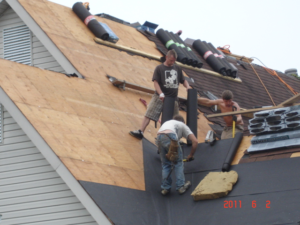
Construction can come with many occupational hazards; workers are around heavy machinery and equipment on a regular basis. However, the leading cause of death for construction workers on the job[1] is something that can happen anywhere – slips, trips, and falls.
From small roofing projects to large-scale commercial construction, the danger is real. One study from the National Institute of Occupational Safety and Health (NIOSH) suggested residential construction contractors did not utilize fall protection equipment, and about one-third of the companies surveyed (66 companies) did not have any safety programs[2].
Another study from The Center for Construction Research and Training (CPWR) states that falling is the most common cause of workplace fatalities among residential construction workers.[3]
“The findings suggest that fall safety within the residential construction industry lags behind commercial construction and construction in industrial settings,” the report reads.
This is not to say there are no regulations in residential construction. But there are separate fall safety guidelines for commercial and residential construction. Those differences can be cumbersome to navigate, but a construction safety expert, particular one who provides expert witness testimony in construction related civil litigation, will be able to identify and differentiate between the fall protection requirements for residential and commercial construction.
In 2011, the Occupational Safety and Health Administration (OSHA) adopted new guidelines for residential construction. The old standards, according to OSHA, “addressed only certain, specified types of residential construction work.” The standard implemented in 2011 also promoted consistency between different states regarding fall protection enforcement for residential construction.
According to OSHA, workers engaged in residential construction six feet or higher must have a conventional fall protection system, such as guardrails, a personal fall safety system, or safety nets. One major change in this standard is the use of slide guards and monitoring systems. Essentially, the new standard stipulates that slide guards and monitoring systems can be used as an alternative, but first it must be proven that conventional fall safety standards are not feasible.[4]
When an employer can demonstrate it is infeasible to use a “standard” fall protection system, the employer can create their own fall protection plan, if it meets other OSHA requirements. These customized fall protection plans must be site-specific.
Commercial construction, on the other hand, comes with additional regulations and compliance depending on the working conditions and situation. There are certain requirements for construction activities such as leading edges, working on steep roofs, formwork, and working on low-slope roofs, for example.
It’s important to consider all options for fall protection during construction, especially the requirements in commercial construction compared to residential. A construction safety expert familiar with OSHA regulations can provide useful input on the need and requirements for fall protection on both commercial and residential construction projects.
[1] Xiuwen Sue Dong, Xuanwen Wang, Julie A. Largay, James W. Platner, Erich Stafford, Chris Trahan Cain, and Sang D. Choi (2014). Fatal falls in the U.S. residential construction industry. Retrieved from: https://www.cpwr.com/sites/default/files/publications/DongFatalFallsInResidentialConstructionKF.pdf.
[2] Sang D. Choi and Katheryn Carlson (2014). Occupational Safety Issues in Residential Construction Surveyed in Wisconsin, United States. Retrieved from: https://www.ncbi.nlm.nih.gov/pmc/articles/PMC4273023/.
[3] Xiuwen Sue Dong, Xuanwen Wang, Julie A. Largay, James W. Platner, Erich Stafford, Chris Trahan Cain, and Sang D. Choi (2014). Fatal falls in the U.S. residential construction industry. Retrieved from: https://www.cpwr.com/sites/default/files/publications/DongFatalFallsInResidentialConstructionKF.pdf.
[4] https://www.osha.gov/doc/fall_protection_factsheet.html
